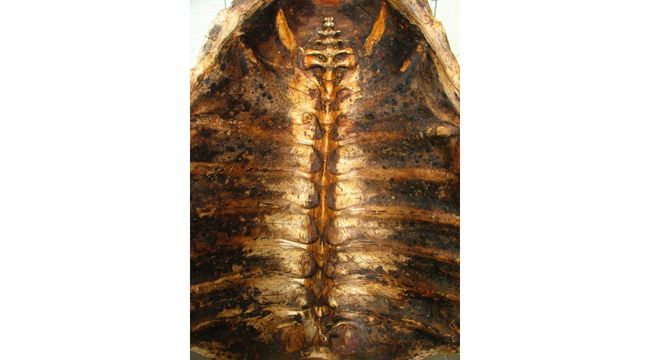
Can Turtles live without their shell?
Do you know that a turtle’s shell is more than just its home? As well as protecting them from predators and the environment, it is also a part of their body.
Every turtle’s shell is critical to its survival; the same applies to pet turtles. In addition to providing protection, they support various biological processes within the turtle’s body.
It’s important for owners to understand why turtles need shells. They should also know what happens if the shell gets damaged. Read on to find out more.
Why Do Turtles Have Shells?
Turtle shells have some obvious advantages. As turtles move, their armor protects them from predators who would like to eat them. A turtle’s shell serves as a very effective means of protecting its internal organs. They began as large rib bones and grew from there. It is hard for them to move fast due to the large, heavy armor they are carrying, but with a tank surrounding you, you do not have to be fast.
It is believed that turtle shells were formed from large, hard ribs that were not only designed to protect turtles but also their ancestors, the Pappochelys. Also, these bones helped the animal float, which means it could rise and fall in water. Due to their buoyant shells, turtles can move much faster in water than on land. However, protection and storage are the most important reasons.
Turtle shells have two main parts:
Carapace—Many people consider the turtle’s carapace to be its back.
Plastron: This is the bottom part of the turtle, which can be considered its belly.
There is a spinal column and a rib cage embedded within the carapace. The plastron protects vital organs such as the lungs and the heart. The shells also protect them from predators. Therefore, both parts of the turtle shell are involved in protecting vital organs.
This is useful when a predator is interested in biting into a turtle. Turtles are commonly preyed upon by raccoons, river otters, minks, foxes, dogs, and cats. There are many predators with strong jaws, but turtle shells are not their match.
There are hard scales called scutes covering shells, which can be as hard as bone. There are many turtle species that can hide in their shells as well.
Turtles are capable of pulling their legs into their shells. In some cases, people are able to pull their heads in directly or by bending their necks. This is, however, dependent on the design of the shell.
When they are attacked by predators, aquatic animals often dive into deep water to escape.
The shell serves many other functions in addition to protecting.
It is also used as a storage container for waste, water, and fats. It serves as the turtle’s primary reservoir for phosphate, carbon dioxide, and a variety of minerals (e.g. calcium, magnesium, and sodium).
Where Do Turtle Shells Come From?
The turtle is one of the most mysterious animals in the world. It’s one of the great and wonderful questions for scientists to ask: How do turtles get their shells?
Turtles have shells, but how and why they have them has long been debated in science.
Turtles and their ancestors are thought to have tough, bony shells formed from their ribs.
It is believed that they have been greatly modified over millions of years and have become the strong, protective armor we know and love about modern turtles today. In contrast, crocodiles get their bony carapaces from growths within their skin called osteoderms. The ribs and vertebrae of turtles grow into the outer skin layers and connect like tectonic plates, creating a solid shell. In turtles, the shell is part of the rest of the skeleton, which is different from crocodiles.
Turtle shells evolved separately from the carapace and plastron, according to evidence.
According to this evidence, the plastron and carapace once served different purposes.
The oldest turtle is Odontochelys semitestacae, 220 million years old. This species’ fossils only have a plastron (the bottom part of the shell) and no carapace. Basically, the plastron appeared first in history, then the carapace evolved some million years later.
However, there are still a lot of questions about this.
According to most scientists, the modern turtle first appeared in the late Triassic Period with the species Proganochelys. This species had a complete shell, including the carapace and plastron.
Can A Turtle Survive Without A Shell?

Turtles need their shells to survive. Is it possible to keep a turtle alive without its shell? I’m sorry, but no! Without it, they probably wouldn’t last a minute or even a second. Turtles’ shells contain the bones and nerve endings they need to live and function.
Turtle shells contain rib cages, spinal cords, and nerve endings, which are important parts of the turtle’s anatomy. It’s made of bone, nerves, and blood vessels.
There are nerve endings in a turtle’s shell, so it can feel when you touch it.
Turtles’ shells are connected to their bodies by nerves and blood vessels. The bones attached to the shell are already part of their bodies. So, there is no barrier between their bones and their internal organs.
In addition to protecting their internal organs, vertebrates can’t live without their spinal cords. Nerve endings and the brain are connected by the spinal cord. Vertebrates can’t move their muscles without the spinal cord.
So turtles are like skinless animals without shells.
It is also important to keep in mind the three other functions of a turtle shell:
Protection: There are a lot of predators that eat turtles with their teeth. However, shells are usually strong enough to stop any serious bites.
pH buffering: This makes the blood pH less acidic, allowing oxygen and other essential molecules to reach all parts of the body.
Storage: As well as storing calcium, magnesium, sodium, phosphate, carbon dioxide, water, fat, and waste, it also holds calcium, magnesium, sodium, phosphate, and carbon dioxide. Each of these nutrients is crucial for their metabolism and normal bodily functions.
Is It Possible For Turtles To Leave Their Shells?
Humans have soft skin and wear clothes to protect themselves. Tortoises and turtles have shells that look like armor. Even their heads, tails, and legs look like they’re sticking out of the shell, like they can just slide out whenever they want.
Are turtles and tortoises able to live without shells? It’s impossible for turtles and tortoises to live without shells. Their shells aren’t something they can slip on and off. They are as much a part of their shell as we are a part of our skeleton. Turtles are connected to their shells through their nerves, skin, ribs, and spinal cord.
Turtles and tortoises have nerve endings in their shells, so if the shell is damaged, it hurts. If you asked a tortoise to live without its shell, it would be like asking a human to live without his skin.
What happens if a turtle cracks its shell?
In most cases, unless there is an infection underneath the shell crack, any soft tissue injuries beneath the crack will recover in a couple of weeks. It may take four to eighteen months for the shell to knit together completely. While some cracks may take years to fully heal, they should be monitored as the turtle ages to ensure that they heal properly.
Read More:



